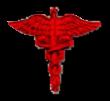 Migratory Birds and the Spread of West Nile Virus in the Western Hemisphere
In the late nineteen-thirties, the chemist, Paul Müller, worked for the J.R. Geigy
company, in Switzerland. He began experimenting with an odorless white crystalline
powder called dichloro-diphenyl-trichloroethane (DDT) in order to kill moths. He
then found that this chemical would kill just about any bug it came in contact with.
After Swiss chemist Paul Müller discovered the insecticidal properties of DDT in 1939,
he was awarded the Nobel Prize for such an innovation.
Typhus--the lethal fever spread by lice--had killed millions of people during and
after the First World War and was lurking throughout the war zones. Worse, in almost
every theatre of operations, malaria-carrying mosquitoes were causing havoc.
That is why DDT was used in Vietnam.
In the heyday of the war on malaria, widespread DDT-spraying campaigns were
used to stifle the pesky bloodsuckers. But DDT played havoc with the environment --
it killed birds and beneficial insects as well as anopheles mosquitoes. And the
mosquitoes eventually gained resistance to DDT, and then to newer insecticides.
Death to Mosquitos
Migratory Birds and the Spread of West Nile Virus in the Western Hemisphere
In the late nineteen-thirties, the chemist, Paul Müller, worked for the J.R. Geigy
company, in Switzerland. He began experimenting with an odorless white crystalline
powder called dichloro-diphenyl-trichloroethane (DDT) in order to kill moths. He
then found that this chemical would kill just about any bug it came in contact with.
After Swiss chemist Paul Müller discovered the insecticidal properties of DDT in 1939,
he was awarded the Nobel Prize for such an innovation.
Typhus--the lethal fever spread by lice--had killed millions of people during and
after the First World War and was lurking throughout the war zones. Worse, in almost
every theatre of operations, malaria-carrying mosquitoes were causing havoc.
That is why DDT was used in Vietnam.
In the heyday of the war on malaria, widespread DDT-spraying campaigns were
used to stifle the pesky bloodsuckers. But DDT played havoc with the environment --
it killed birds and beneficial insects as well as anopheles mosquitoes. And the
mosquitoes eventually gained resistance to DDT, and then to newer insecticides.
Death to Mosquitos
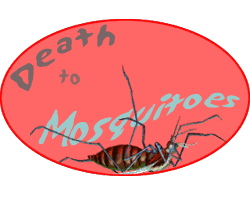 West Nile virus, an Old World flavivirus related to St. Louis encephalitis virus,
was first recorded in the New World during August 1999 in the borough of Queens,
New York City. Through October 1999, 62 patients, 7 of whom died, had confirmed
infections with the virus. Ornithophilic mosquitoes are the principal vectors of
West Nile virus in the Old World, and birds of several species, chiefly migrants,
appear to be the major introductory or amplifying hosts.
If transovarial transmission or survival in overwintering mosquitoes were the principal
means for its persistence, West Nile virus might not become established in the New World
because of aggressive mosquito suppression campaigns conducted in the New York area.
However, the pattern of outbreaks in southern Europe suggests that viremic migratory
birds may also contribute to movement of the virus. If so, West Nile virus has the
potential to cause outbreaks throughout both temperate and tropical regions of the
Western Hemisphere.
The lineage associated with the New York outbreak has been identified as virtually
identical with an Israeli strain of the virus by phylogenetic analysis of
E-glycoprotein nucleic acid sequence data. West Nile virus was one of the most
widespread flaviviruses, even before its recent entry into North America. Its
distribution extends throughout Africa, the Middle East, and southern temperate and
tropical Eurasia. During the 1950s, an estimated 40% of the human population
in Egypt's Nile Delta was seropositive for the virus. The largest human epidemic
occurred in Cape Province, South Africa, in 1974, when approximately 3,000 clinical
cases of the virus were recorded.
Outbreaks of the virus in temperate regions generally occur during late summer or early
fall, coinciding with the arrival of large concentrations of migratory birds (and
mosquitoes).
West Nile virus, an Old World flavivirus related to St. Louis encephalitis virus,
was first recorded in the New World during August 1999 in the borough of Queens,
New York City. Through October 1999, 62 patients, 7 of whom died, had confirmed
infections with the virus. Ornithophilic mosquitoes are the principal vectors of
West Nile virus in the Old World, and birds of several species, chiefly migrants,
appear to be the major introductory or amplifying hosts.
If transovarial transmission or survival in overwintering mosquitoes were the principal
means for its persistence, West Nile virus might not become established in the New World
because of aggressive mosquito suppression campaigns conducted in the New York area.
However, the pattern of outbreaks in southern Europe suggests that viremic migratory
birds may also contribute to movement of the virus. If so, West Nile virus has the
potential to cause outbreaks throughout both temperate and tropical regions of the
Western Hemisphere.
The lineage associated with the New York outbreak has been identified as virtually
identical with an Israeli strain of the virus by phylogenetic analysis of
E-glycoprotein nucleic acid sequence data. West Nile virus was one of the most
widespread flaviviruses, even before its recent entry into North America. Its
distribution extends throughout Africa, the Middle East, and southern temperate and
tropical Eurasia. During the 1950s, an estimated 40% of the human population
in Egypt's Nile Delta was seropositive for the virus. The largest human epidemic
occurred in Cape Province, South Africa, in 1974, when approximately 3,000 clinical
cases of the virus were recorded.
Outbreaks of the virus in temperate regions generally occur during late summer or early
fall, coinciding with the arrival of large concentrations of migratory birds (and
mosquitoes).
Fight the bite
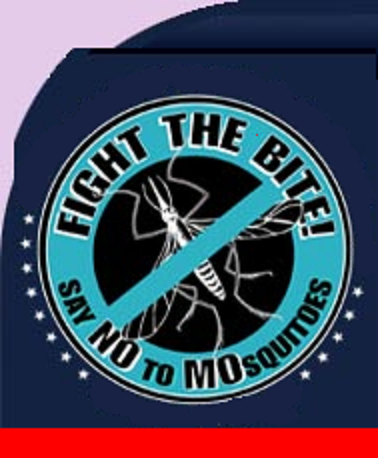
The West Nile Virus Can Kill!
The symptoms of severe infection (West Nile encephalitis or meningitis) can include
headache, high fever, neck stiffness, muscle weakness, stupor, disorientation, tremors,
convulsions, paralysis, and coma. It is estimated that one in 150 persons infected with
the West Nile virus will develop the more severe form of the disease. Usually, symptoms
occur from three to 14 days after exposure. There is no specific treatment for viral
infections, other than to treat the symptoms and provide supportive care.
Always try to boost your immune system to fight disease by eating lots of healthy
fruits and vegetables!
 West Nile Virus Lymphocytic Perivascular Infiltration
West Nile Virus Lymphocytic Perivascular Infiltration
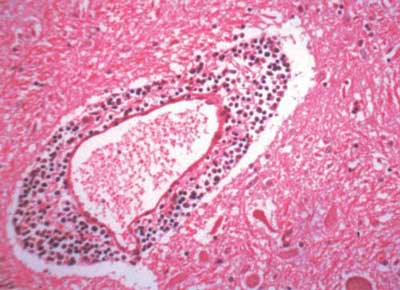 West Nile Virus
West Nile virus first appeared in the Americas in New York City in 1999,
with 62 human cases. It is mainly a disease of wild birds. In just four years,
migrating birds carried the virus all the way across the U.S., Canada, Mexico
and the Caribbean. Weekly maps from the CDC traced the spread of animal
and human infections across the U.S.
2005 West Nile Virus Activity in the United States
West Nile Virus
West Nile virus first appeared in the Americas in New York City in 1999,
with 62 human cases. It is mainly a disease of wild birds. In just four years,
migrating birds carried the virus all the way across the U.S., Canada, Mexico
and the Caribbean. Weekly maps from the CDC traced the spread of animal
and human infections across the U.S.
2005 West Nile Virus Activity in the United States
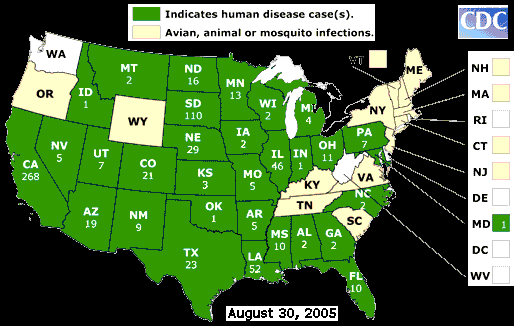
 In a small number of individuals, however, West Nile virus can cause more serious
disease. Seniors or very young children are at increased risk of developing more
severe symptoms because there immunity system is not as strong as an healthy
adult. The symptoms including headache, confusion, weakness, paralysis, and seizures.
At its most serious, the infection can result in coma and death. Symptoms usually
occur five to 15 days following the bite of an infected mosquito.
Because West Nile encephalitis is a viral infection, antibiotics are not effective
and there is no specific treatment available.
West Nile virus is transmitted through the bite of a mosquito that becomes infected
with the virus by feeding on an infected bird.
Should you talk about West Nile Disease if you have it?
Yes, "I'm all for talking about it because it's a lonely disease," said many
sufferers of this infection which causes depression to memory loss,
and in exteme cases, death.
In Colorado, the West Nile Disease killed 61 people in 2003.
One sufferer continues to battle blurry vision, migraine headaches and muscle weakness.
"I can't imagine somebody going through what I went through," was the typical
reaction of those infected.
--------------------------------------------------------------------------------
West Nile Virus
--------------------------------------------------------------------------------
Each week, the National Atlas will include a new series of maps resulting from ongoing
West Nile Virus surveillance activities led by the Centers for Disease Control and
Prevention (CDC). West Nile Virus has emerged in recent years in temperate regions of
Europe and North America, presenting a threat to public health, equine health, and
since 1999, the health of bird populations. The most serious manifestation of infection
is fatal encephalitis (inflammation of the brain) in humans and horses, as well as
mortality in certain domestic and wild birds
What are arbovirus infections?
Arbovirus (short for arthropod-borne) infections are caused by any number of viruses
transmitted by arthropods such as mosquitoes and ticks.These infections generally occur
during warm weather months when mosquitoes and ticks are active. Lyme disease and Rocky
Mountain spotted fever are not caused by viruses and are not considered arbovirus
infections.
Arbovirus Infection
In a small number of individuals, however, West Nile virus can cause more serious
disease. Seniors or very young children are at increased risk of developing more
severe symptoms because there immunity system is not as strong as an healthy
adult. The symptoms including headache, confusion, weakness, paralysis, and seizures.
At its most serious, the infection can result in coma and death. Symptoms usually
occur five to 15 days following the bite of an infected mosquito.
Because West Nile encephalitis is a viral infection, antibiotics are not effective
and there is no specific treatment available.
West Nile virus is transmitted through the bite of a mosquito that becomes infected
with the virus by feeding on an infected bird.
Should you talk about West Nile Disease if you have it?
Yes, "I'm all for talking about it because it's a lonely disease," said many
sufferers of this infection which causes depression to memory loss,
and in exteme cases, death.
In Colorado, the West Nile Disease killed 61 people in 2003.
One sufferer continues to battle blurry vision, migraine headaches and muscle weakness.
"I can't imagine somebody going through what I went through," was the typical
reaction of those infected.
--------------------------------------------------------------------------------
West Nile Virus
--------------------------------------------------------------------------------
Each week, the National Atlas will include a new series of maps resulting from ongoing
West Nile Virus surveillance activities led by the Centers for Disease Control and
Prevention (CDC). West Nile Virus has emerged in recent years in temperate regions of
Europe and North America, presenting a threat to public health, equine health, and
since 1999, the health of bird populations. The most serious manifestation of infection
is fatal encephalitis (inflammation of the brain) in humans and horses, as well as
mortality in certain domestic and wild birds
What are arbovirus infections?
Arbovirus (short for arthropod-borne) infections are caused by any number of viruses
transmitted by arthropods such as mosquitoes and ticks.These infections generally occur
during warm weather months when mosquitoes and ticks are active. Lyme disease and Rocky
Mountain spotted fever are not caused by viruses and are not considered arbovirus
infections.
Arbovirus Infection
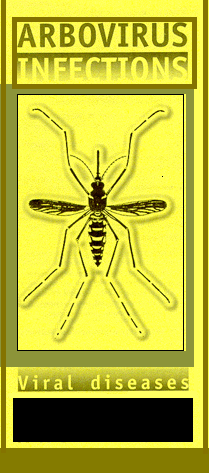 ARBOVIRAL ENCEPHALITIS
What is arboviral encephalitis?
Encephalitis is an inflammation of the brain that can be caused by arboviruses
(viruses carried by arthropods, such as mosquitoes and ticks) or by other types
of viruses. In Illinois, arboviruses are primarily transmitted to humans by the
bites of infected mosquitoes.
St. Louis encephalitis, West Nile virus and LaCrosse (California) encephalitis
are the arboviral diseases most likely to occur in Illinois. These infections are
most common in June through October when mosquitoes are active. Although they produce
similar symptoms, these viruses vary in severity and, typically, affect different age
groups. Fortunately, these types of viruses are transmitted by only a few types of
mosquitoes and, usually, only a small proportion of those mosquitoes actually carry
the virus.
ARBOVIRAL ENCEPHALITIS
What is arboviral encephalitis?
Encephalitis is an inflammation of the brain that can be caused by arboviruses
(viruses carried by arthropods, such as mosquitoes and ticks) or by other types
of viruses. In Illinois, arboviruses are primarily transmitted to humans by the
bites of infected mosquitoes.
St. Louis encephalitis, West Nile virus and LaCrosse (California) encephalitis
are the arboviral diseases most likely to occur in Illinois. These infections are
most common in June through October when mosquitoes are active. Although they produce
similar symptoms, these viruses vary in severity and, typically, affect different age
groups. Fortunately, these types of viruses are transmitted by only a few types of
mosquitoes and, usually, only a small proportion of those mosquitoes actually carry
the virus.
 How is arboviral encephalitis spread?
Infection with an arbovirus occurs only through the bite of an infected insect.
These diseases are not transmitted from person to person. In Illinois, the primary
vector (carrier) of St. Louis encephalitis and West Nile virus is the northern house
mosquito (Culex pipiens). The northern house mosquito breeds in small stagnant bodies
of water and receptacles--such as discarded tin cans, flower urns, old tires, buckets
and other containers--that hold water. The mosquitoes are infected with the St. Louis
encephalitis and West Nile virus when they bite infected birds.
The mosquito that transmits LaCrosse encephalitis is the tree-hole mosquito (Aedes
triseriatus). Found in many wooded areas, the tree-hole mosquito breeds in water-filled
discarded tires and other containers and in tree holes. LaCrosse encephalitis infection
in mosquitoes occurs when they bite small mammals or when an infected female mosquito
transmits the infection to her offspring.
About two weeks after a heavy rain, large numbers of "floodwater" mosquitoes (such
asAedes vexans) can emerge from river floodplains and flooded woods. Although they
can be a major nuisance problem for several weeks, floodwater mosquitoes have not been
significant disease carriers in Illinois.
What are the symptoms of encephalitis?
Most persons bitten by an infected mosquito will experience no symptoms of the disease
or will have very mild symptoms only. Approximately 1 percent to 2 percent will develop
recognizable symptoms. The symptoms of West Nile Virus, St. Louis encephalitis and
LaCrosse encephalitis are similar. Some persons may have mild symptoms, such as a fever
and headache. Severe infection may produce a rapid onset of severe headache, high fever,
muscle aches, stiffness in the back of the neck, problems with muscle coordination,
disorientation, convulsions and coma. Symptoms usually occur five to 15 days after the
bite of an infected mosquito.
How is encephalitis diagnosed and treated?
An arbovirus infection is usually diagnosed through a blood test. A follow-up blood
test two or three weeks after the onset of symptoms is almost always necessary to
confirm an arbovirus diagnosis. A physician will attempt to relieve symptoms of the
illness, but there is no specific medication available to treat or cure the disease.
How is arboviral encephalitis spread?
Infection with an arbovirus occurs only through the bite of an infected insect.
These diseases are not transmitted from person to person. In Illinois, the primary
vector (carrier) of St. Louis encephalitis and West Nile virus is the northern house
mosquito (Culex pipiens). The northern house mosquito breeds in small stagnant bodies
of water and receptacles--such as discarded tin cans, flower urns, old tires, buckets
and other containers--that hold water. The mosquitoes are infected with the St. Louis
encephalitis and West Nile virus when they bite infected birds.
The mosquito that transmits LaCrosse encephalitis is the tree-hole mosquito (Aedes
triseriatus). Found in many wooded areas, the tree-hole mosquito breeds in water-filled
discarded tires and other containers and in tree holes. LaCrosse encephalitis infection
in mosquitoes occurs when they bite small mammals or when an infected female mosquito
transmits the infection to her offspring.
About two weeks after a heavy rain, large numbers of "floodwater" mosquitoes (such
asAedes vexans) can emerge from river floodplains and flooded woods. Although they
can be a major nuisance problem for several weeks, floodwater mosquitoes have not been
significant disease carriers in Illinois.
What are the symptoms of encephalitis?
Most persons bitten by an infected mosquito will experience no symptoms of the disease
or will have very mild symptoms only. Approximately 1 percent to 2 percent will develop
recognizable symptoms. The symptoms of West Nile Virus, St. Louis encephalitis and
LaCrosse encephalitis are similar. Some persons may have mild symptoms, such as a fever
and headache. Severe infection may produce a rapid onset of severe headache, high fever,
muscle aches, stiffness in the back of the neck, problems with muscle coordination,
disorientation, convulsions and coma. Symptoms usually occur five to 15 days after the
bite of an infected mosquito.
How is encephalitis diagnosed and treated?
An arbovirus infection is usually diagnosed through a blood test. A follow-up blood
test two or three weeks after the onset of symptoms is almost always necessary to
confirm an arbovirus diagnosis. A physician will attempt to relieve symptoms of the
illness, but there is no specific medication available to treat or cure the disease.
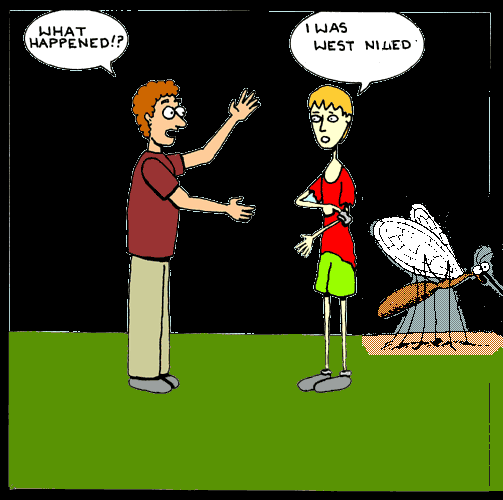 Emotional Support
When you are diagnosed with the West Nile Virus, you probably turn first
to your family, friends, and church for help. You need the presence of people
who not only care for you, but who try hard to understand what you are feeling.
Another great source of support is in taking to other West Nile sufferers, since
they are going through the same thing that you are and probably already know what
you are feeling.
Building up of the immunity system is very important as well as not getting
to stressed out from the devastating disease.
Life Cycle of a Mosquito
Mosquitoes of different species lay their eggs in a variety of water sources that
range from small containers to vast expanses of marshland. The larval stage is always
aquatic and shuttles from the subsurface where it filter feeds on micro-organisms to
the surface to obtain oxygen through a snorkel-like breathing apparatus. The pupal
stage does not feed but unlike most Insect pupae is extremely active. The adult emerges
from the pupal case using air pressure and assume a terrestrial existence.
Some mosquitoes are capable of transmitting diseases such as malaria, yellow fever,
dengue, filariasis and encephalitis [St. Louis encephalitis (SLE), Western Equine
encephalitis (WEE), LaCrosse encephalitis (LAC), Japanese encephalitis (JE), Eastern
Equine encephalitis (EEE) and West Nile virus (WNV)] to humans and animals.
Emotional Support
When you are diagnosed with the West Nile Virus, you probably turn first
to your family, friends, and church for help. You need the presence of people
who not only care for you, but who try hard to understand what you are feeling.
Another great source of support is in taking to other West Nile sufferers, since
they are going through the same thing that you are and probably already know what
you are feeling.
Building up of the immunity system is very important as well as not getting
to stressed out from the devastating disease.
Life Cycle of a Mosquito
Mosquitoes of different species lay their eggs in a variety of water sources that
range from small containers to vast expanses of marshland. The larval stage is always
aquatic and shuttles from the subsurface where it filter feeds on micro-organisms to
the surface to obtain oxygen through a snorkel-like breathing apparatus. The pupal
stage does not feed but unlike most Insect pupae is extremely active. The adult emerges
from the pupal case using air pressure and assume a terrestrial existence.
Some mosquitoes are capable of transmitting diseases such as malaria, yellow fever,
dengue, filariasis and encephalitis [St. Louis encephalitis (SLE), Western Equine
encephalitis (WEE), LaCrosse encephalitis (LAC), Japanese encephalitis (JE), Eastern
Equine encephalitis (EEE) and West Nile virus (WNV)] to humans and animals.
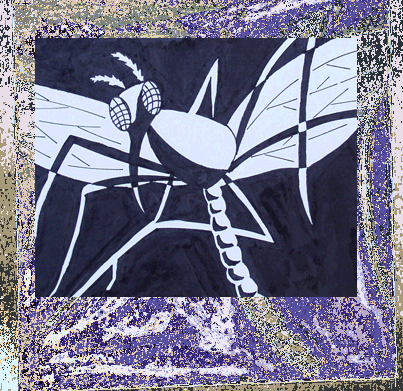 Only female mosquitoes require a blood meal and bite animals - warm or cold blooded -
and birds. Stimuli that influence biting (blood feeding) include a combination of carbon
dioxide, temperature, moisture, smell, color and movement. Male mosquitoes do not bite,
but feed on the nectar of flowers or other suitable sugar source. Acquiring a blood meal
(protein) is essential for egg production, but mostly both male and female mosquitoes
are nectar feeders. Female Toxorhynchites actually can't obtain a bloodmeal and are
restricted to a nectar diet. Of those female mosquitoes capable of blood feeding, human
blood meals are seldom first or second choices. Horses, cattle, smaller mammals and/or
birds are preferred.
Aedes and Ochlerotatus mosquitoes are painful and persistent biters. They search for a
blood meal early in the morning, at dusk (crepuscular feeders) and into the evening.
Some are diurnal (daytime biters) especially on cloudy days and in shaded areas. They
usually do not enter dwellings, and they prefer to bite mammals like humans. Aedes and
Ochlerotatus mosquitoes are strong fliers and are known to fly many miles from their
breeding sources.
Culex mosquitoes are painful and persistent biters also, but prefer to attack at dusk
and after dark. They readily enter dwellings for blood meals. Domestic and wild birds
usually are preferred over man, cows, and horses. Culex nigripalpus is known to transmit
St. Louis encephalitis to man in Florida. Culex mosquitoes are generally weak fliers and
do not move far from home, although they have been known to fly up to two miles. Culex
usually live only a few weeks during the warm summer months. Those females that emerge
in late summer search for sheltered areas where they "hibernate" until spring. Warm
weather brings them out again in search of water on which to lay their eggs.
Culiseta mosquitoes are moderately aggressive biters, attacking in the evening hours
or in the shade during the day. Psorophora, Coquillettidia and Mansonia mosquitoes are
becoming more pestiferous as an ever-expanding human population invades their natural
habitats. Anopheles mosquitoes are persistent biters and are the only mosquitoes which
transmit malaria to man.
--------------------------------------------------------------------------------
Only female mosquitoes require a blood meal and bite animals - warm or cold blooded -
and birds. Stimuli that influence biting (blood feeding) include a combination of carbon
dioxide, temperature, moisture, smell, color and movement. Male mosquitoes do not bite,
but feed on the nectar of flowers or other suitable sugar source. Acquiring a blood meal
(protein) is essential for egg production, but mostly both male and female mosquitoes
are nectar feeders. Female Toxorhynchites actually can't obtain a bloodmeal and are
restricted to a nectar diet. Of those female mosquitoes capable of blood feeding, human
blood meals are seldom first or second choices. Horses, cattle, smaller mammals and/or
birds are preferred.
Aedes and Ochlerotatus mosquitoes are painful and persistent biters. They search for a
blood meal early in the morning, at dusk (crepuscular feeders) and into the evening.
Some are diurnal (daytime biters) especially on cloudy days and in shaded areas. They
usually do not enter dwellings, and they prefer to bite mammals like humans. Aedes and
Ochlerotatus mosquitoes are strong fliers and are known to fly many miles from their
breeding sources.
Culex mosquitoes are painful and persistent biters also, but prefer to attack at dusk
and after dark. They readily enter dwellings for blood meals. Domestic and wild birds
usually are preferred over man, cows, and horses. Culex nigripalpus is known to transmit
St. Louis encephalitis to man in Florida. Culex mosquitoes are generally weak fliers and
do not move far from home, although they have been known to fly up to two miles. Culex
usually live only a few weeks during the warm summer months. Those females that emerge
in late summer search for sheltered areas where they "hibernate" until spring. Warm
weather brings them out again in search of water on which to lay their eggs.
Culiseta mosquitoes are moderately aggressive biters, attacking in the evening hours
or in the shade during the day. Psorophora, Coquillettidia and Mansonia mosquitoes are
becoming more pestiferous as an ever-expanding human population invades their natural
habitats. Anopheles mosquitoes are persistent biters and are the only mosquitoes which
transmit malaria to man.
--------------------------------------------------------------------------------
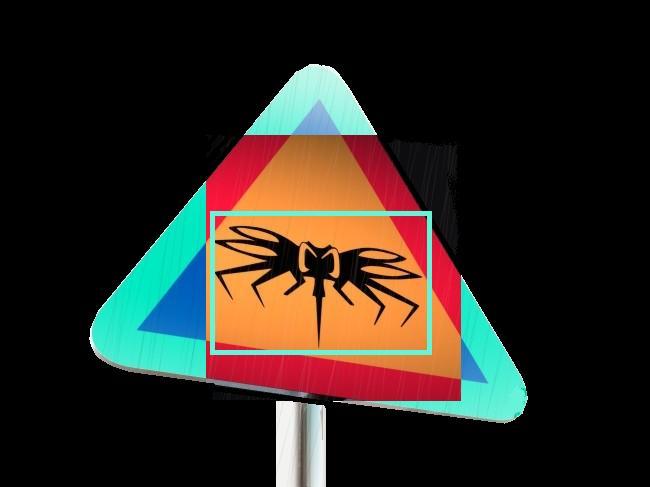 Remember to take Anti-oxidents to build up your immunity to fight infection
and disease. (Raw Fruits and Vegetables)
Please verify all information with your Doctor before you try any of the
information which has been described above.
Remember to take Anti-oxidents to build up your immunity to fight infection
and disease. (Raw Fruits and Vegetables)
Please verify all information with your Doctor before you try any of the
information which has been described above.
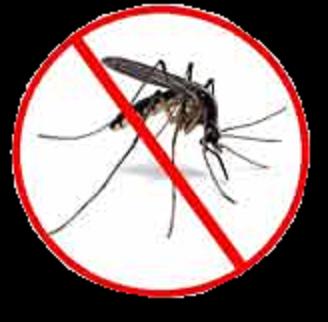 Take care, and I hope the cure to the West Nile Infection will be found soon!
West Nile Virus Cases in 2004
Take care, and I hope the cure to the West Nile Infection will be found soon!
West Nile Virus Cases in 2004
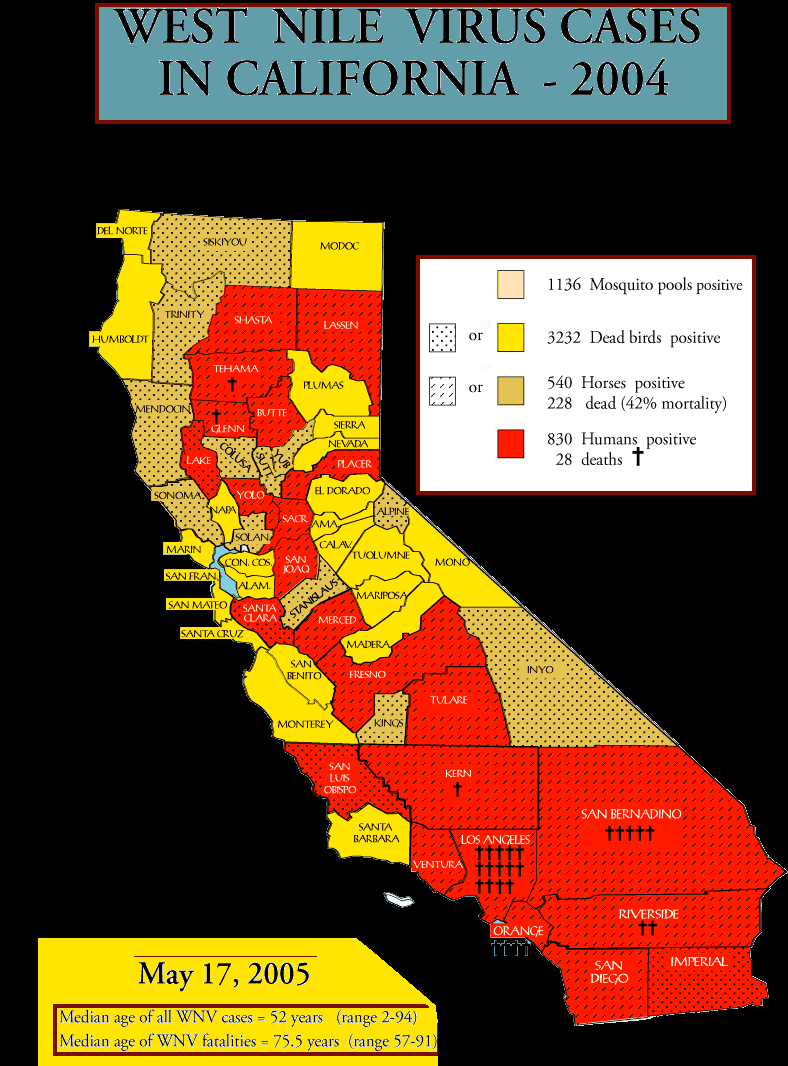 Hope is sometimes all that one has. God speed with your recovery!
Hope is sometimes all that one has. God speed with your recovery!

Free Hit Counter

 Migratory Birds and the Spread of West Nile Virus in the Western Hemisphere
In the late nineteen-thirties, the chemist,
Migratory Birds and the Spread of West Nile Virus in the Western Hemisphere
In the late nineteen-thirties, the chemist,  West Nile virus, an Old World
West Nile virus, an Old World 
 West Nile Virus Lymphocytic Perivascular Infiltration
West Nile Virus Lymphocytic Perivascular Infiltration
 West Nile Virus
West Nile virus first appeared in the Americas in New York City in 1999,
with 62 human cases. It is mainly a disease of wild birds. In just four years,
migrating birds carried the virus all the way across the U.S., Canada, Mexico
and the Caribbean. Weekly maps from the CDC traced the spread of animal
and human infections across the U.S.
2005 West Nile Virus Activity in the United States
West Nile Virus
West Nile virus first appeared in the Americas in New York City in 1999,
with 62 human cases. It is mainly a disease of wild birds. In just four years,
migrating birds carried the virus all the way across the U.S., Canada, Mexico
and the Caribbean. Weekly maps from the CDC traced the spread of animal
and human infections across the U.S.
2005 West Nile Virus Activity in the United States

 In a small number of individuals, however, West Nile virus can cause more serious
disease. Seniors or very young children are at increased risk of developing more
severe symptoms because there immunity system is not as strong as an healthy
adult. The symptoms including headache, confusion, weakness, paralysis, and seizures.
At its most serious, the infection can result in coma and death. Symptoms usually
occur five to 15 days following the bite of an infected mosquito.
Because West Nile encephalitis is a viral infection, antibiotics are not effective
and there is no specific treatment available.
West Nile virus is transmitted through the bite of a mosquito that becomes infected
with the virus by feeding on an infected bird.
Should you talk about West Nile Disease if you have it?
Yes, "I'm all for talking about it because it's a lonely disease," said many
sufferers of this infection which causes depression to memory loss,
and in exteme cases, death.
In Colorado, the West Nile Disease killed 61 people in 2003.
One sufferer continues to battle blurry vision, migraine headaches and muscle weakness.
"I can't imagine somebody going through what I went through," was the typical
reaction of those infected.
--------------------------------------------------------------------------------
West Nile Virus
--------------------------------------------------------------------------------
Each week, the National Atlas will include a new series of maps resulting from ongoing
West Nile Virus surveillance activities led by the Centers for Disease Control and
Prevention (CDC). West Nile Virus has emerged in recent years in temperate regions of
Europe and North America, presenting a threat to public health, equine health, and
since 1999, the health of bird populations. The most serious manifestation of infection
is fatal encephalitis (inflammation of the brain) in humans and horses, as well as
mortality in certain domestic and wild birds
What are arbovirus infections?
Arbovirus (short for arthropod-borne) infections are caused by any number of viruses
transmitted by arthropods such as mosquitoes and ticks.These infections generally occur
during warm weather months when mosquitoes and ticks are active. Lyme disease and Rocky
Mountain spotted fever are not caused by viruses and are not considered arbovirus
infections.
Arbovirus Infection
In a small number of individuals, however, West Nile virus can cause more serious
disease. Seniors or very young children are at increased risk of developing more
severe symptoms because there immunity system is not as strong as an healthy
adult. The symptoms including headache, confusion, weakness, paralysis, and seizures.
At its most serious, the infection can result in coma and death. Symptoms usually
occur five to 15 days following the bite of an infected mosquito.
Because West Nile encephalitis is a viral infection, antibiotics are not effective
and there is no specific treatment available.
West Nile virus is transmitted through the bite of a mosquito that becomes infected
with the virus by feeding on an infected bird.
Should you talk about West Nile Disease if you have it?
Yes, "I'm all for talking about it because it's a lonely disease," said many
sufferers of this infection which causes depression to memory loss,
and in exteme cases, death.
In Colorado, the West Nile Disease killed 61 people in 2003.
One sufferer continues to battle blurry vision, migraine headaches and muscle weakness.
"I can't imagine somebody going through what I went through," was the typical
reaction of those infected.
--------------------------------------------------------------------------------
West Nile Virus
--------------------------------------------------------------------------------
Each week, the National Atlas will include a new series of maps resulting from ongoing
West Nile Virus surveillance activities led by the Centers for Disease Control and
Prevention (CDC). West Nile Virus has emerged in recent years in temperate regions of
Europe and North America, presenting a threat to public health, equine health, and
since 1999, the health of bird populations. The most serious manifestation of infection
is fatal encephalitis (inflammation of the brain) in humans and horses, as well as
mortality in certain domestic and wild birds
What are arbovirus infections?
Arbovirus (short for arthropod-borne) infections are caused by any number of viruses
transmitted by arthropods such as mosquitoes and ticks.These infections generally occur
during warm weather months when mosquitoes and ticks are active. Lyme disease and Rocky
Mountain spotted fever are not caused by viruses and are not considered arbovirus
infections.
Arbovirus Infection
 ARBOVIRAL ENCEPHALITIS
What is arboviral encephalitis?
Encephalitis is an inflammation of the brain that can be caused by arboviruses
(viruses carried by arthropods, such as mosquitoes and ticks) or by other types
of viruses. In Illinois, arboviruses are primarily transmitted to humans by the
bites of infected mosquitoes.
St. Louis encephalitis, West Nile virus and
ARBOVIRAL ENCEPHALITIS
What is arboviral encephalitis?
Encephalitis is an inflammation of the brain that can be caused by arboviruses
(viruses carried by arthropods, such as mosquitoes and ticks) or by other types
of viruses. In Illinois, arboviruses are primarily transmitted to humans by the
bites of infected mosquitoes.
St. Louis encephalitis, West Nile virus and  How is arboviral encephalitis spread?
Infection with an arbovirus occurs only through the bite of an infected insect.
These diseases are not transmitted from person to person. In Illinois, the primary
vector (carrier) of St. Louis encephalitis and West Nile virus is the northern house
mosquito (Culex pipiens). The northern house mosquito breeds in small stagnant bodies
of water and receptacles--such as discarded tin cans, flower urns, old tires, buckets
and other containers--that hold water. The mosquitoes are infected with the St. Louis
encephalitis and West Nile virus when they bite infected birds.
The mosquito that transmits LaCrosse encephalitis is the tree-hole mosquito (Aedes
triseriatus). Found in many wooded areas, the tree-hole mosquito breeds in water-filled
discarded tires and other containers and in tree holes. LaCrosse encephalitis infection
in mosquitoes occurs when they bite small mammals or when an infected female mosquito
transmits the infection to her offspring.
About two weeks after a heavy rain, large numbers of "floodwater" mosquitoes (such
asAedes vexans) can emerge from river floodplains and flooded woods. Although they
can be a major nuisance problem for several weeks, floodwater mosquitoes have not been
significant disease carriers in Illinois.
What are the symptoms of encephalitis?
Most persons bitten by an infected mosquito will experience no symptoms of the disease
or will have very mild symptoms only. Approximately 1 percent to 2 percent will develop
recognizable symptoms. The symptoms of West Nile Virus, St. Louis encephalitis and
LaCrosse encephalitis are similar. Some persons may have mild symptoms, such as a fever
and headache. Severe infection may produce a rapid onset of severe headache, high fever,
muscle aches, stiffness in the back of the neck, problems with muscle coordination,
disorientation, convulsions and coma. Symptoms usually occur five to 15 days after the
bite of an infected mosquito.
How is encephalitis diagnosed and treated?
An arbovirus infection is usually diagnosed through a blood test. A follow-up blood
test two or three weeks after the onset of symptoms is almost always necessary to
confirm an arbovirus diagnosis. A physician will attempt to relieve symptoms of the
illness, but there is no specific medication available to treat or cure the disease.
How is arboviral encephalitis spread?
Infection with an arbovirus occurs only through the bite of an infected insect.
These diseases are not transmitted from person to person. In Illinois, the primary
vector (carrier) of St. Louis encephalitis and West Nile virus is the northern house
mosquito (Culex pipiens). The northern house mosquito breeds in small stagnant bodies
of water and receptacles--such as discarded tin cans, flower urns, old tires, buckets
and other containers--that hold water. The mosquitoes are infected with the St. Louis
encephalitis and West Nile virus when they bite infected birds.
The mosquito that transmits LaCrosse encephalitis is the tree-hole mosquito (Aedes
triseriatus). Found in many wooded areas, the tree-hole mosquito breeds in water-filled
discarded tires and other containers and in tree holes. LaCrosse encephalitis infection
in mosquitoes occurs when they bite small mammals or when an infected female mosquito
transmits the infection to her offspring.
About two weeks after a heavy rain, large numbers of "floodwater" mosquitoes (such
asAedes vexans) can emerge from river floodplains and flooded woods. Although they
can be a major nuisance problem for several weeks, floodwater mosquitoes have not been
significant disease carriers in Illinois.
What are the symptoms of encephalitis?
Most persons bitten by an infected mosquito will experience no symptoms of the disease
or will have very mild symptoms only. Approximately 1 percent to 2 percent will develop
recognizable symptoms. The symptoms of West Nile Virus, St. Louis encephalitis and
LaCrosse encephalitis are similar. Some persons may have mild symptoms, such as a fever
and headache. Severe infection may produce a rapid onset of severe headache, high fever,
muscle aches, stiffness in the back of the neck, problems with muscle coordination,
disorientation, convulsions and coma. Symptoms usually occur five to 15 days after the
bite of an infected mosquito.
How is encephalitis diagnosed and treated?
An arbovirus infection is usually diagnosed through a blood test. A follow-up blood
test two or three weeks after the onset of symptoms is almost always necessary to
confirm an arbovirus diagnosis. A physician will attempt to relieve symptoms of the
illness, but there is no specific medication available to treat or cure the disease.
 Emotional Support
When you are diagnosed with the West Nile Virus, you probably turn first
to your family, friends, and church for help. You need the presence of people
who not only care for you, but who try hard to understand what you are feeling.
Another great source of support is in taking to other West Nile sufferers, since
they are going through the same thing that you are and probably already know what
you are feeling.
Building up of the
Emotional Support
When you are diagnosed with the West Nile Virus, you probably turn first
to your family, friends, and church for help. You need the presence of people
who not only care for you, but who try hard to understand what you are feeling.
Another great source of support is in taking to other West Nile sufferers, since
they are going through the same thing that you are and probably already know what
you are feeling.
Building up of the  Only female mosquitoes require a blood meal and bite animals - warm or cold blooded -
and birds. Stimuli that influence biting (blood feeding) include a combination of carbon
dioxide, temperature, moisture, smell, color and movement. Male mosquitoes do not bite,
but feed on the nectar of flowers or other suitable sugar source. Acquiring a blood meal
(protein) is essential for egg production, but mostly both male and female mosquitoes
are nectar feeders. Female Toxorhynchites actually can't obtain a bloodmeal and are
restricted to a nectar diet. Of those female mosquitoes capable of blood feeding, human
blood meals are seldom first or second choices. Horses, cattle, smaller mammals and/or
birds are preferred.
Aedes and Ochlerotatus mosquitoes are painful and persistent biters. They search for a
blood meal early in the morning, at dusk (crepuscular feeders) and into the evening.
Some are diurnal (daytime biters) especially on cloudy days and in shaded areas. They
usually do not enter dwellings, and they prefer to bite mammals like humans. Aedes and
Ochlerotatus mosquitoes are strong fliers and are known to fly many miles from their
breeding sources.
Culex mosquitoes are painful and persistent biters also, but prefer to attack at dusk
and after dark. They readily enter dwellings for blood meals. Domestic and wild birds
usually are preferred over man, cows, and horses. Culex nigripalpus is known to transmit
St. Louis encephalitis to man in Florida. Culex mosquitoes are generally weak fliers and
do not move far from home, although they have been known to fly up to two miles. Culex
usually live only a few weeks during the warm summer months. Those females that emerge
in late summer search for sheltered areas where they "hibernate" until spring. Warm
weather brings them out again in search of water on which to lay their eggs.
Culiseta mosquitoes are moderately aggressive biters, attacking in the evening hours
or in the shade during the day. Psorophora, Coquillettidia and Mansonia mosquitoes are
becoming more pestiferous as an ever-expanding human population invades their natural
habitats. Anopheles mosquitoes are persistent biters and are the only mosquitoes which
transmit malaria to man.
--------------------------------------------------------------------------------
Only female mosquitoes require a blood meal and bite animals - warm or cold blooded -
and birds. Stimuli that influence biting (blood feeding) include a combination of carbon
dioxide, temperature, moisture, smell, color and movement. Male mosquitoes do not bite,
but feed on the nectar of flowers or other suitable sugar source. Acquiring a blood meal
(protein) is essential for egg production, but mostly both male and female mosquitoes
are nectar feeders. Female Toxorhynchites actually can't obtain a bloodmeal and are
restricted to a nectar diet. Of those female mosquitoes capable of blood feeding, human
blood meals are seldom first or second choices. Horses, cattle, smaller mammals and/or
birds are preferred.
Aedes and Ochlerotatus mosquitoes are painful and persistent biters. They search for a
blood meal early in the morning, at dusk (crepuscular feeders) and into the evening.
Some are diurnal (daytime biters) especially on cloudy days and in shaded areas. They
usually do not enter dwellings, and they prefer to bite mammals like humans. Aedes and
Ochlerotatus mosquitoes are strong fliers and are known to fly many miles from their
breeding sources.
Culex mosquitoes are painful and persistent biters also, but prefer to attack at dusk
and after dark. They readily enter dwellings for blood meals. Domestic and wild birds
usually are preferred over man, cows, and horses. Culex nigripalpus is known to transmit
St. Louis encephalitis to man in Florida. Culex mosquitoes are generally weak fliers and
do not move far from home, although they have been known to fly up to two miles. Culex
usually live only a few weeks during the warm summer months. Those females that emerge
in late summer search for sheltered areas where they "hibernate" until spring. Warm
weather brings them out again in search of water on which to lay their eggs.
Culiseta mosquitoes are moderately aggressive biters, attacking in the evening hours
or in the shade during the day. Psorophora, Coquillettidia and Mansonia mosquitoes are
becoming more pestiferous as an ever-expanding human population invades their natural
habitats. Anopheles mosquitoes are persistent biters and are the only mosquitoes which
transmit malaria to man.
--------------------------------------------------------------------------------
 Remember to take Anti-oxidents to build up your immunity to fight infection
and disease. (Raw Fruits and Vegetables)
Please verify all information with your Doctor before you try any of the
information which has been described above.
Remember to take Anti-oxidents to build up your immunity to fight infection
and disease. (Raw Fruits and Vegetables)
Please verify all information with your Doctor before you try any of the
information which has been described above.
 Take care, and I hope the cure to the West Nile Infection will be found soon!
Take care, and I hope the cure to the West Nile Infection will be found soon!
